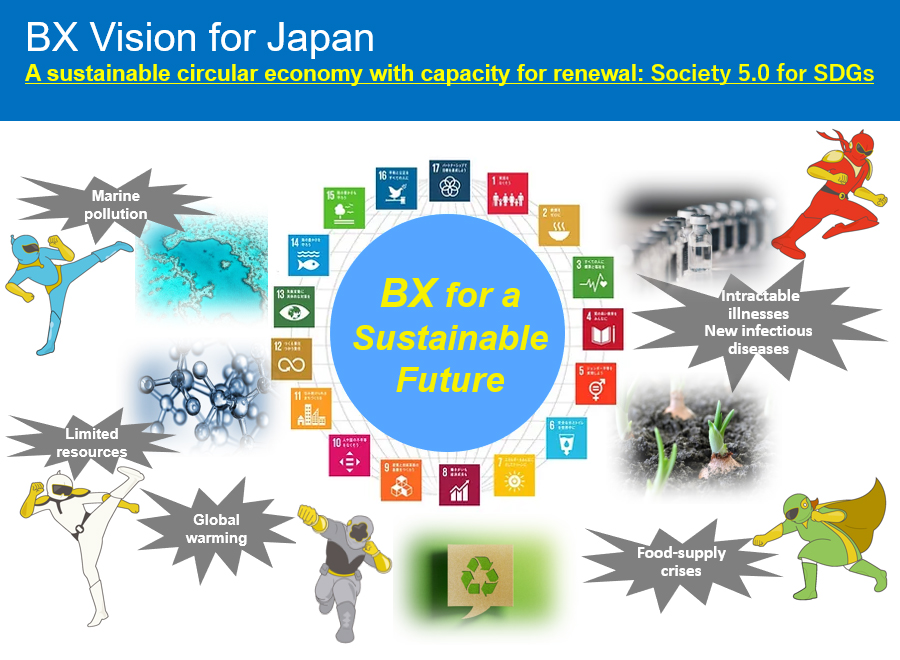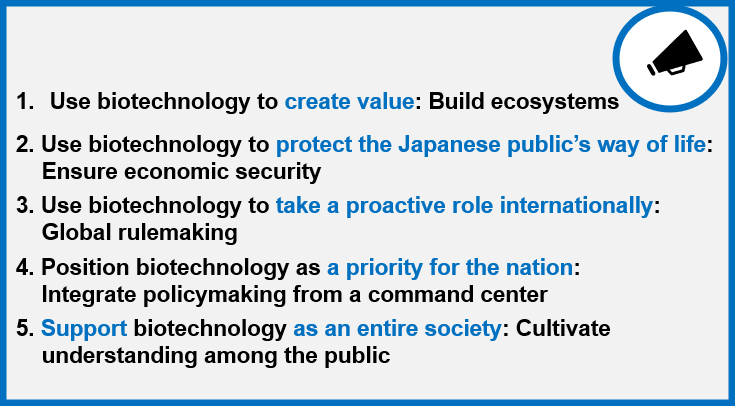Keidanren

I. Introduction
Recent years have brought rapid advances in terms of increasingly fast, low-cost genome sequencing, technological innovation in genome editing, and the merging of biotechnology with digital technologies such as artificial intelligence (AI). Developments such as these have improved the prospects for the emergence of bioeconomies, in which biotechnologies underpin the foundations of a broad range of industries.
Advances in biotechnology could transform the very nature of society itself by providing solutions to societal issues such as environmental destruction and limited resources, while at the same time delivering sustainable economic growth. In other words, biotechnological advances have the potential to bring about biotechnologial transformation (BX). This is easy to understand if one considers the societal changes wrought by digital transformation (DX). In recent years, DX has employed digital technologies as tools to transform products, services, and business models, not only in IT-related businesses, but across a wide range of industries, thereby dramatically changing societies and the lives of citizens. BX is the same. The impacts of leveraging dramatically improved biotechnologies as tools will transform business models not only in those companies that actually possess specific biotechnologies, but throughout a broad array of industries. Such transformation will encompass methods used for product R&D, as well as raw materials, manufacturing methods, and resource recycling. Taking advantage of biotechnologies in this way has the potential to cause industrial restructuring and to fundamentally alter the way societies as a whole obtain and use resources, energy, and food. It could be described as the fifth industrial revolution, following on from DX, which was referred to as the fourth industrial revolution.
The Organisation for Economic Co-operation and Development (OECD) predicts that the value of the biotechnology industry in OECD member countries will grow to around 200 trillion yen in 2030.#1 In the United States, the Biden administration published a Fact Sheet in 2022 regarding an Executive Order signed by the president and an initiative to implement this Executive Order. The Fact Sheet predicted that biomanufacturing could account for more than a third of global output of manufacturing industries by 2030, thereby growing into a market worth 30 trillion US dollars in terms of global manufacturing output.#2
Other major economies, too, have recognized the importance of BX in terms of both economic growth and national security, and are accelerating the relevant initiatives, including drawing up national strategies with clear schedules for putting BX into practice. In Japan, the government started formulating its Bioeconomy Strategy in 2019; during the process of reviewing and updating the strategy, it set the goal of realizing the world's most advanced bioeconomy society by 2030.#3 Moreover, Japan's Basic Policy on Economic and Fiscal Management and Reform 2022—approved by the Cabinet in June 2022—listed quantum technologies and AI, as well as biotechnology and medical fields such as biomanufacturing, regenerative/cellular medicine, and gene therapies, as the science and technology fields that are directly linked to Japan's national interests.#4
However, successful use of biotechnologies is still beset by challenges. For example, products manufactured using biotechnologies are more expensive than existing products, reducing their ability to compete in the marketplace; or the markets for such products are not yet sufficiently developed. To ensure that BX does not end in failure, therefore, Japan's industrial representatives, government, and the public need to join forces to answer the question of how to deal with these challenges.
In June 2022, Keidanren addressed the developments outlined above by setting up its Committee on Bioeconomy, and has exchanged views with government representatives and experts on multiple occasions. In this proposal, Keidanren presents its BX vision for Japan, as well as strategies and specific measures to achieve that vision. In addition, on behalf of Japan's business community, we declare our commitment and readiness to take on the BX challenge in collaboration with a wide range of stakeholders.
II. BX Vision for Japan
The biotechnologies supporting BX have applications in a diverse array of fields, making them extremely wide-ranging. They can be classified using five different colors according to their fields of application. The classifications are: "white biotech" in manufacturing and energy fields including biomaterials and biofuels, "green biotech" in food production and plant-related fields including high-yield crops and effective use of forestry resources, "red biotech" in medical and healthcare fields including regenerative/cellular medicine and gene therapies, "blue biotech" in the marine field including conservation of marine resources and CO2-absorbing algae, and "gray biotech" in the environmental field including recycling of waste and environmental cleaning. Below are some examples of solutions to societal issues that are expected in each field.

White Biotech (Manufacturing and Energy)
As potential solutions to environmental problems such as global warming and limited resources, expectations are high with regard to manufacturing that uses biomass,#5 or microbes that have been highly functionally modified to possess specific capabilities, without relying on fossil resources (biomanufacturing). Such biomanufacturing can curtail the use of fossil resources as raw materials or sources of energy, and can also reduce greenhouse gas emissions by taking place under gentler conditions than chemical processes, or by using CO2 in the air as a raw material. Moreover, the power of biotechnology is expected to be used to make plastics biodegradable in soil, and eventually in the sea. Making plastics, which contribute to environmental pollution, capable of decomposition in the soil or the sea promises a potential means of reducing pollution.

Green Biotech
(Food Production and Plant-Related)
Use of gene modification technology enables plant varieties to be improved in order to increase crop yields or make crops more nutritious, and this can be achieved more quickly than is possible using conventional methods. Meanwhile, progress is also being made in developing methods for efficient production of alternative protein sources including meat substitutes made from plant-based protein such as soybeans or man-made synthetic protein, as well as insect-based food, and lab-grown meat made by culturing animal cells. These technologies could provide solutions to the destabilization of food production and supply due to the growing world population and the effects of climate change. It would be possible to provide high-quality foods meeting personalized requirements in terms of improved flavor or enhanced benefits to health. In addition, forestry resources are one form of resource that Japan has in abundance, and using them effectively would result in a higher degree of resource self-sufficiency, as well as progress away from reliance on fossil resources.

Red Biotech (Medical and Healthcare)
Regenerative/cellular medicine uses living cells to restore impaired physical functions or mitigate the symptoms of disease, while gene therapies replenish or adjust the genes inside cells to treat illness. Treatments developed using these innovative technologies (regenerative medicine products) can contribute to public health by offering new treatment options to patients suffering from intractable diseases and other illnesses that are difficult to treat with existing medicines. Moreover, as the Covid-19 vaccines proved, the perfect example of a situation in which red bio played a key role was the rapid development, manufacturing, and supply of vaccines and medicines when a new infectious disease emerged.

Blue Biotech (Marine)
In Japan, which possesses the sixth largest exclusive economic zone in the world and boasts an abundance of marine resources, expectations are also high with regard to the use of biotechnologies in the marine field. Improvements to varieties of fish and shellfish can be used to increase feed efficiency (i.e., growth per unit of feed consumed) or make individual fish or shellfish bigger to address issues relating to marine food supply. It is also possible to use varieties of algae engineered to absorb higher volumes of CO2, or produce more fats and oils, as sources of energy, or to increase the production of useful substances using marine organisms.

Gray Biotech (Environment)
Microbes suited to waste water treatment could be used to reduce the volume of sewage sludge incinerated, as well as greenhouse gas emissions resulting from waste water treatment. Besides, cleaning of polluted soil using microbes is a promising treatment technology that is low-cost as well as environmentally friendly. In addition, fertilization of soil by using mycorrhizal fungi#6 to fix carbon in the ground is contributing to progress in research aimed at achieving carbon neutrality and solving food shortages. Initiatives are also under way to collect recyclable resources efficiently and undertake more recycling.
Thus, biotechnologies could be put to use in a wide range of fields, enabling Japan to move away from economic growth dependent on fossil resources, and offering the potential for radically innovative solutions to societal issues affecting the entire planet, such as global warming, resource shortages, food-supply crises, marine pollution, intractable illnesses, and new infectious diseases. Accordingly, the society that Japan should be aiming to achieve through BX is a sustainable circular economy with capacity for renewal that has a track record of using cutting-edge biotechnologies to overcome the diverse range of problems confronting the world. This corresponds exactly to the Society 5.0 for SDGs concept, which Keidanren has been advocating for some time already; that is to say, it is a society that constantly innovates and creates new businesses, thereby managing to solve societal issues while at the same time delivering economic growth.
Keidanren is pressing for Japan to invest actively in fields with biotechnology applications and to proceed with real-world implementation of these technologies, aiming for Japan to be the first country in the world to put BX into practice. Japan should then roll BX out globally to contribute to solving societal issues worldwide, while positioning the biotech industry as a key industry that drives its growth.

III. The Five Strategies

It is vital that Japan be the first country in the world to put BX into practice. This is because the resources necessary to implement BX, including personnel, technologies, funding, and information, are likely to accumulate in the countries and regions that make concerted efforts in this regard, and that will in turn attract further resources, creating a virtuous cycle. If Japan's efforts are ahead of other countries' efforts, it will also be able to take a leading role in the rulemaking process. In other words, there is a massive first-mover advantage.
It cannot be denied that the United States and European countries have led the way in developing the bioeconomy concept and related strategies. However, when it comes to the real-world implementation of biotechnologies, all countries remain in the exploratory stages, and Japan could still catch up with even these leaders. In the medical field, Japan is one of the few countries in the world capable of conducting continuous drug discovery, and in the field of regenerative medicine, it has made outstanding progress on applied research into induced pluripotent stem (iPS) cells. In the biomanufacturing field, Japan boasts world-class R&D capabilities, particularly in the development of distinctive products, such as bioplastics that are biodegradable in the sea and textiles created by microbes. Given that biotechnology is knowledge-intensive, and is also said to require ingenuity at the production stage, it is a highly promising field for Japan, in which our country could rank among the best in the world for manufacturing, our long-established forte. What is more, it is a field in which even a country with limited resources, such as Japan, could increase its domestic supply capability by, for example, exploiting its own unused resources. That is precisely why it is of paramount importance for Japanese industry and government to join forces with academia and the public to take action on BX with a sense of urgency.
To meet this imperative, Keidanren is proposing its Five Strategies and declaring that the Japanese business community will play a proactive role in their implementation. It is by creating new value through biotechnology, delivering that value where it is needed, and extending this endeavor globally that societal issues affecting the entire world can be solved. Doing so will require initiatives to ensure that such value is created reliably and is properly evaluated. In addition, as explained at the beginning of this proposal, the fields in which biotechnologies could make a contribution are extremely diverse. Japan will therefore need to be capable of aligning a multitude of measures and bringing various stakeholders together onto the same path in order to achieve its BX vision.
Strategy 1 Use biotechnology to create value: Build ecosystems
R&D in the biotechnology sphere is increasingly complex and advanced, and biomanufacturing, like R&D, is expected to require massive upfront investment. In upstream manufacturing, predictions suggest that use of new technologies such as AI and robots will increase, while downstream developments are expected to include increasingly sophisticated culturing technologies. Accordingly, each individual stage of the value chain will require use of specialized technologies, along with investment in the appropriate equipment, which is likely to lead to an increasingly "horizontal" division of efforts, involving input from multiple players. Moreover, in the biotechnology sphere, where technologies are evolving fast and their fields of application are wide-ranging, the merging of different fields is vital to ensure continuous innovation. In order to promote horizontal division of efforts and the merging of different fields, it will be essential to build ecosystems in which a variety of players connect organically.
Above all, the key to building ecosystems is the development of startups, which will provide the driving force for innovation within such ecosystems through revolutionary technologies and business models. Outside of Japan, large biotech clusters exist in the Cambridge-Boston area of Massachusetts and elsewhere, and they attract personnel, technologies, funding, and information from around the world, producing a great many startups that achieve success on the world stage. Meanwhile, within Japan, local communities all over the country are authorized by the government to take the lead in building ecosystems and implementing measures to stimulate the biotech industry.#7 However, the resulting "biocommunities" remain underdeveloped and have very limited influence compared to those overseas.
It is now imperative that Japan's industry, academia, and government work in unison to build up our country's biocommunities, which enable the creation of value chains that seamlessly integrate the process from creating seeds to launching a business and starting commercial production. In biocommunities overseas, such as MassBio (in Boston)#8 and Biocom (in San Diego),#9 organizations and individuals called "community-builders" play a major role in reinforcing ecosystems, primarily by creating mechanisms that organically connect representatives of industry, academia, and government within the community. In Japan, likewise, each biocommunity's executive office needs to take the lead in instituting a similar setup.
Furthermore, the government should go beyond simply authorizing such biocommunities and work with local authorities to make a long-term commitment to them and provide financial support. In addition, it should take steps such as rapidly pursuing the necessary regulatory and institutional reforms by utilizing special zones and other measures, setting up a base for a national research and development agency for such biocommunities and continuously dispatching personnel to this agency, and supporting biocommunities with overseas expansion. However, when providing such support, if the government simply replicates a successful biocommunity by creating similar biocommunities elsewhere, there is a risk that the competitive advantages of individual biocommunities could be compromised. It is therefore important to make the most of each region's strengths and aim to establish biocommunities that are unique and unrivaled, providing them with continuous support.
Keidanren is strengthening its collaboration with the government, academia, and biocommunities in various locations, while steadily implementing the startup promotion measures set out in its policy proposal entitled Vision for Startup Breakthrough.#10 That is to say, we will create ecosystems in which large companies and startups can make the most of their respective strengths to co-create value. To this end, we will move beyond minor investments of corporate venture capital (CVC), which until now have been the main way in which large companies partner with startups, and instead accelerate new partnership initiatives. These would include large companies making their resources including personnel, technologies, and information available to startups and offering them opportunities and locations for collaboration, setting up new core businesses through M&A targeting startups, or creating business carve-outs or spin-offs from inhouse ventures.
Strategy 2 Use biotechnology to protect the Japanese public's way of life: Ensure economic security
Cutting-edge science and technology are fundamental both to economic development and to the protection of Japanese citizens' lives and way of life. As a field of technology that has a direct impact on Japanese people's lives and health in terms of medicines, food, and the natural environment, biotechnology in particular plays a vital role in ensuring that Japan's economic security is unassailable. In the United States, an agency within the Department of Defense called the Defense Advanced Research Projects Agency (DARPA) provides financial support for the latest science and technology from the national defense budget. In biotech and other deep tech fields, Japan should learn from DARPA's funding methods and allocate budget funds to a large number of state-of-the-art technologies, starting with small amounts and building up incrementally. For biotech, venture capital (VC) investment is particularly difficult to obtain in the early stages, largely due to potential investors' inability to assess the relevant technologies.
Another issue is that international competition to secure the raw materials needed for production of bioproducts has already started. Japan is dependent on imports from overseas for many of the raw materials for production of bioproducts, such as plant-based and pharmaceutical raw materials, and this makes reliable procurement of such materials a pressing issue. Besides, raw materials are not the only issue; Japan also needs to expand and maintain the capacity of factories producing bioproducts domestically. The worldwide grain shortage caused by Russia's invasion of Ukraine is still a very recent memory. The measures individual countries took to limit exports of medical supplies at the height of the Covid-19 pandemic served as a reminder that greater reliance on imports from overseas presents a major risk in terms of economic security, not only when it relates to raw materials, but also in relation to bioproducts such as vaccines or medicines. For Japan, bolstering our domestic production infrastructure is an urgent task. Increased capacity to produce raw materials and bioproducts will cause a new problem: insufficient specialist personnel to undertake such production. Given that personnel cannot be trained overnight, as a matter of urgency Japan needs to start nurturing personnel who are familiar with increasingly advanced biomanufacturing technologies and good manufacturing practice (GMP),#11 as well as how the relevant manufacturing equipment functions.
Keidanren will bolster efforts to reliably procure biotech raw materials and to expand and maintain the capacity of factories producing bioproducts in order to ensure that Japan's economic security is unassailable. In addition, we will seek to train biotechnology specialists by collaborating with academia and the government to improve specialist training, including through partnerships with technical colleges. To facilitate active contribution by such specialists, we will initiate discussions with the relevant parties regarding support to encourage job mobility.
Strategy 3 Use biotechnology to take a proactive role internationally: Global rulemaking
In order to leverage rapid advances in the biotechnology field to generate innovation and roll out new businesses internationally, it is essential to ensure a level playing field. Japan must therefore lose no time in reviewing its regulations and institutions that have not kept up with scientific and technological progress. It is crucial that global rulemaking allows for the international competitiveness of our own country's industry to be strengthened, and Japan itself must therefore become a rulemaker. As countries worldwide fight desperately for supremacy in the biotechnology sphere, we must take a strategic approach toward developments in rulemaking and global standardization. Prevailing in the competition around international rulemaking and global markets requires us to maintain a solid foundation of technological prowess while consciously improving capabilities such as diplomatic negotiation skills, political influence, ability to gather and distribute information, financial power, and human resource capacity.
For example, given that DSI (digital sequence information) on genetic resources is intangible, it should not normally be subject to sharing of financial benefits. Despite this, however, the recent UN Biodiversity Conference (COP 15) arrived at a political agreement to include the sharing of benefits from DSI in its adopted targets. The next UN Biodiversity Conference (COP 16) will address and discuss topics such as specific methods for sharing benefits, the definition of DSI, and the scope of its use. Japan therefore needs to take a sufficiently strategic approach to protect its own national interests.
Keidanren is seeking solutions to issues affecting Japan's regulatory regime by lobbying the government. At the same time, we are collaborating closely with the government to ensure that the opinions of Japanese companies are reflected in international rulemaking.
Strategy 4 Position biotechnology as a priority for the nation: Integrate policymaking from a command center
Biotechnologies have applications in a diverse array of fields, making them extremely wide-ranging, and many biotechnology initiatives transcend the boundaries of existing industrial sectors. However, Japan's biotech-related policymaking to date gives the undeniable impression that individual ministries and agencies have acted separately, restricting their efforts to the industries under their own jurisdiction. The background to this situation was that, despite Japan's national biotechnology-related strategy and measures having originated with the Biotechnology Strategy Outline of 2002, the government as a whole took no steps to monitor, check, or review progress in implementing the strategy. Because such efforts were instead undertaken by the relevant ministries and agencies according to their own priorities, Japan ended up falling behind other countries over the last 20 years. Under such circumstances, Japanese industry also failed to make the long-term objective of achieving BX fundamental to its approach when liaising with the government. That is why we are calling for the establishment of an organization inside the government that can function as a command center to pursue integrated measures to promote biotechnology. Japan needs to position biotechnology as a national priority and create such a command center within central government to collaborate with individual ministries and agencies, and with local governments, as well as aligning its efforts with industry. Moreover, it is companies such as (deep tech-related) startups that will provide the driving force for promotion of biotechnology, but as such companies take time to grow, it will be necessary to reconsider the most suitable funding arrangements for the biotech field and further increase the number of medium- to long-term funding projects. For example, in its biotech promotion measures, the government could avoid setting single-year budgets, and instead adopt arrangements such as setting up funds to secure stable budgets spanning multiple years, which it could allocate flexibly.
As described in the introduction to this proposal, biotechnology has the potential to transform business models across a broad array of industrial sectors, causing industrial restructuring, and to fundamentally alter the way societies as a whole obtain and use resources, energy, and food. It cannot be denied that such a process could disrupt existing markets, exposing some market players to a struggle for survival. However, considering the ever-increasing demands of dealing with environmental issues worldwide, along with the resource- and energy-related issues we face as a nation, and issues with regard to Japan's food security, we have no choice but to regard BX as inevitable. Accordingly, the government will need to be capable of drawing up a BX strategy from a broad perspective and implementing such change as smoothly as possible. That process is likely to necessitate discussion among a diverse range of stakeholders. Difficult problems abound, but the business community will join the government in engaging actively with such discussions.
Strategy 5 Support biotechnology as an entire society: Cultivate understanding among the public
In order to promote widespread uptake of bioproducts and create associated markets, the public needs to be receptive to such products, having understood the facts regarding the added value and long-term cost-savings they deliver.
Keidanren plans to liaise with the government, taking an even more proactive approach to clearly explaining such added value and cost-saving benefits to the public in order to facilitate their understanding. First, we will show in visual form how bioproducts can benefit our daily lives and the natural environment. Second, we will seek to dispel the worries and concerns (generally safety-related) that arise when new technologies such as genome editing appear, by taking the initiative in releasing information and offering repeated opportunities for discussion. Third, we will inform the public that, although bio-derived products cost more than conventional products in the short term, the total benefits they can provide over the medium to long term surpass those of conventional products, offering excellent value overall. Thus, we will seek to win the public over by highlighting the balance between cost and benefits. To improve cost competitiveness, Japanese industry should step up the pace of its technological innovation. In conjunction with this, the government should support industry's efforts from a policy perspective by exploring the possibility of providing incentives for bioproduct production and use or establishing a subsidy system to protect and develop production of raw materials and energy within Japan.
IV. Conclusion
This proposal has addressed the challenge of achieving BX, setting out a vision for Japan, along with the issues to be tackled, and Keidanren's commitment to the endeavor. BX has the potential to establish a great balance between solving societal issues and enhancing economic growth, thereby realizing Society 5.0 for SDGs. Consequently, Keidanren has high expectations of BX, and is making it central to all its activities.
Nonetheless, the real-world implementation of BX presents a great many challenges in terms of regulations and institutions, the environment, and other considerations. In the industrial sphere, the BX process will force some industries, companies, and business divisions to transition away from their existing business models, and dealing with that transition is unlikely to be an easy experience. Even so, the tidal wave of global BX has already reached Japan's shores, just as it did with DX (digital transformation). We should not ignore this tidal wave, but should instead take advantage of it to find solutions to the societal issues this country faces; that is the course of action we must choose as a country that espouses the concept of Society 5.0 for SDGs.
Keidanren intends to focus on driving BX forward by confronting the issues hindering its implementation and liaising with stakeholders including the relevant industries, the national government, and local authorities to urgently seek solutions to these issues.
- OECD, The Bioeconomy to 2030: Designing a Policy Agenda
https://www.oecd.org/futures/long-termtechnologicalsocietalchallenges
/thebioeconomyto2030designingapolicyagenda.htm - The White House, Fact Sheet: President Biden to Launch a National Biotechnology and Biomanufacturing Initiative
https://www.whitehouse.gov/briefing-room/statements-releases/2022/09/12/fact-sheet-
president-biden-to-launch-a-national-biotechnology-and-biomanufacturing-initiative/ - Cabinet Office, Bioeconomy Strategy (in Japanese only)
https://www8.cao.go.jp/cstp/bio/index.html - Basic Policy on Economic and Fiscal Management and Reform 2022
https://www5.cao.go.jp/keizai-shimon/kaigi/cabinet/2022/2022_basicpolicies_en.pdf - Biomass denotes organic resources derived from plants and animals (excluding fossil resources).
- Fungi that produce mycorrhizae (literally "fungal roots") to live symbiotically with plants. For example, many of the mushrooms that grow aboveground in forests are mycorrhizal, with threadlike mycelium under the soil that attaches to the surface or interior of plant roots.
- Cabinet Office, Information on Biocommunities (in Japanese only)
https://www8.cao.go.jp/cstp/bio/bio_community_siryo.html - MassBio
https://www.massbio.org/about/ - Biocom
https://www.biocom.org/about/ - Keidanren, Vision for Startup Breakthrough
https://www.keidanren.or.jp/en/policy/2022/024.html - The standards governing management of production processes and quality control relating to pharmaceutical products.

